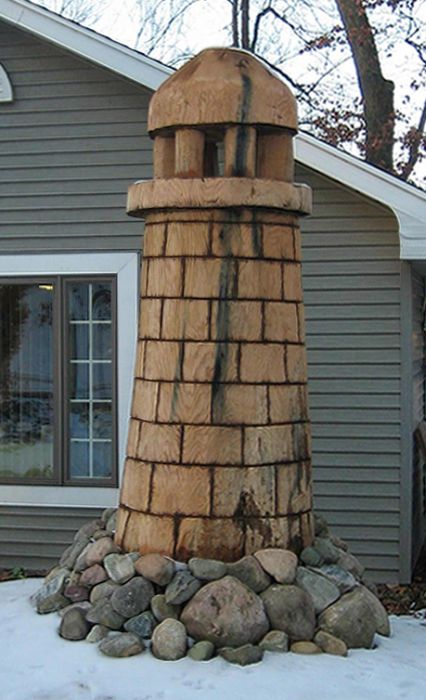Finishing a Chain-Saw Carved Oak Tree
Here's a one-of-a-kind challenge: finish this lighthouse sculpture, carved from a standing oak stump using a chain saw. March 29, 2008
Question
This is outside my professional experience, but I want to help this client as a favor. An amateur chainsaw artist carved a lighthouse out of her black oak tree still in the ground (and added a little woodburning). The nearly 200-year-old tree in southern Michigan was topped at 10 feet because upper branches were rotted. It was 45" diameter at breast height. The lighthouse is not hollow; there was no rotting below the point at which it was topped. It was carved from July through November. It will always be outdoors, in part shade, part sun. It is 10 feet tall and stands about 6 feet from the client's house. The carver left bark around the bottom of the trunk (no carving there) and piled rocks around it to a height of a foot or more. The client likes the natural look of the wood, but wouldn’t mind some staining. She likes the handmade look, and seeing the wood grain. Of course she does not want it to crack, rot, mold or become very discolored. (The discoloration you see in the photo is the result of the many spikes found in the tree; I plan to try to bleach out those gray streaks.) I'm thinking I'll use a marine spar varnish. It is cold in Michigan now, and I'm not sure whether the tree will discolor if we wait until warmer weather to apply the finish. Any suggestions about which specific product to use and when to apply it?

Click here for higher quality, full size image
Forum Responses
(Finishing Forum)
From contributor R:
I can't comment on the finish for this beautiful piece of artwork, but I might wish a billion ants inhibit your arm pits if you bleach out those wonderful grey streaks that took nature year upon year upon year to create.
From the original questioner:
Thanks for the comment. I have mixed feelings about the gray streaks in the lighthouse. On the one hand, they are an interesting part of the tree's history. On the other hand, they look like a mistake to those who do not know that history. We will discuss that some more. I'd be interested in seeing what others think about this issue.
From contributor Z:
I have seen something used called
Watco teak oil finish. It is marine finish for boats and they use it outside. It also protects against UV and mildew. This sounds like what you need.
From contributor R:
Could the carver put down a few words as to how the tree evolved into a lighthouse? That would solve it. Bleaching walnut is a job in itself and since these streaks are embedded into the wood, there's no telling how deep they actually are. You just might end up burning the wood trying to remove the streaks with a bleach solution.
From contributor C:
I would do what others said, using the oil. Apply it with a pump-up sprayer. That thing is awesome!
From contributor T:
I believe you said the tree was black oak? A hot saturated solution of oxalic acid in water will neutralize those unnatural black iron stains, and will keep the ants at bay too. (Be sure to read, understand and follow the instructions.) As for a finish, the last thing I would do is apply a film building finish. You're just asking for a lot of maintenance problems. I'd suggest a good exterior oil which you can just refresh each year.
From contributor Y:
A couple of suggestions. Preservatives: this is a wet piece of wood that will remain wet for a couple of years because of the sheer size of it. There are a couple of styles of wood preservative out there and the one I recommend is a water based/soluble family of products that are boron-based. There are liquid and solid forms. They are environmentally friendly but work as both anti-microbial as well as insecticidal. The solid form is called Impel rods and one form of the liquid is called Borocol. Once you have treated for rot, then I would suggest a non-film-forming exterior stain because a film former will have problems dealing with the long term high moisture content. I use a product called Sansin Classic. Also environmentally friendly.
The comments below were added after this Forum discussion was archived as a Knowledge Base article (add your comment).
Comment from contributor S:
I am the sculptor of this tree and it has been a few years since finishing it. It has turned a grayish color as it has aged. I believe the original poster and owner of this sculpture treated the tree and the color still faded. I recently finished another lighthouse and feel fairly confident that spars oil based treatment will do the trick. My mailbox is a bear and it held its color through the last year, winter and all. I had to apply it thick though. The recent lighthouse took three gallons and I suggested the owner add two more for the second coat as it is around 13 feet tall. It seems to give it a laminated look that preserves the woods original color.
